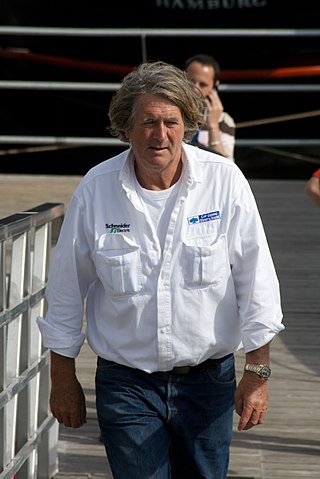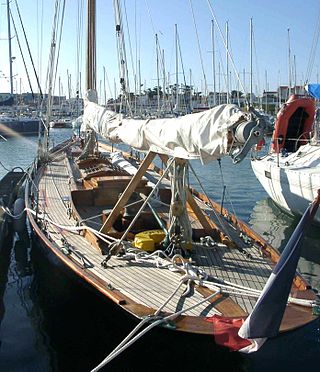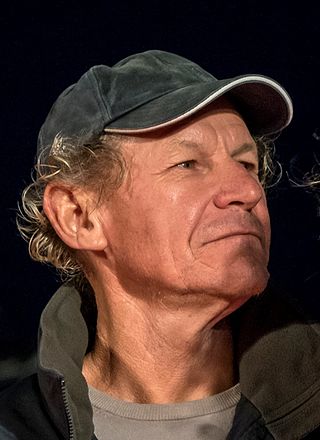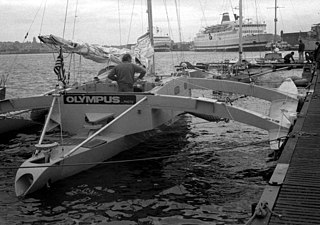
A sailboat or sailing boat is a boat propelled partly or entirely by sails and is smaller than a sailing ship. Distinctions in what constitutes a sailing boat and ship vary by region and maritime culture.
The Single-handed Trans-Atlantic Race (STAR) is an east-to-west yacht race across the North Atlantic. When inaugurated in 1960, it was the first single-handed ocean yacht race; it is run from Plymouth in England to Newport, Rhode Island in the United States, and has generally been held on a four yearly basis.

Éric Marcel Guy Tabarly was a French Navy officer and yachtsman. He developed a passion for offshore racing very early on and won several ocean races such as the Ostar in 1964 and 1976, ending English domination in this specialty. Several of his wins broke long standing records. He owed his successes to his exceptional mastery of sailing and of each one of his boats, to both physical and mental stamina and, in some cases, to technological improvements built into his boats. Through his victories, Tabarly inspired an entire generation of ocean racers and contributed to the development of nautical activities in France.
Arthur Piver was a World War II pilot, an amateur sailor, author, printshop owner and renowned boatbuilder who lived in Mill Valley on San Francisco Bay and became "the father of the modern multihull."

Olivier de Kersauson de Pennendreff is a French sailor and sailing champion.

ORMA 60 is a class of sailing trimarans administered by the Ocean Racing Multihull Association (ORMA) that created in 1996 by the International Sailing Federation (ISAF) within the sport of sailing. The boats were built to a box rule that permitted 60 feet length and beam and a 100-foot mast.
Bruce Tweeddale Dalling was a Springbok South African yachtsman, also advocate and farmer, best known for taking second place on elapsed time and first on corrected time for the monohull award in the 1968 Observer Single-Handed Trans-Atlantic Race.

Pen Duick is the name best known for a series of ocean racing yachts sailed by French yachtsman Eric Tabarly. Meaning coal tit in Breton it was the name Tabarly's father gave to the 1898 Fife gaff cutter he purchased, and that his son learned to sail. He thereafter used the name for a series of successful racing yachts through the '60s and '70s.

Banque Populaire V, is an offshore-racing trimaran which was originally run by Team Banque Populaire. It was Team Banque Populaire's fifth boat designed to set oceanic records. She was launched on 4 October 2008 in Nantes, France. She holds multiple records for sailing over set courses, as well as the record for distance sailed in 24 hours by any class of sailing boat, 908.2 nm.

Loïck Peyron is a French yachtsman, younger brother of the yachtsman Bruno Peyron.
VPLP design is a French-based naval architectural firm founded by Marc Van Peteghem and Vincent Lauriot-Prévost, responsible for designing some of the world's most innovative racing boats. Their designs presently hold many of the World Speed Sailing records.

Marc Pajot is a French sailor. He has been a crew member on Éric Tabarly’s boats.

Alain Colas was a French sailor, the first to complete a solitary round-the-world race in a multihull. He met Éric Tabarly in Sydney in 1967, and bought Pen Duick IV from him in 1970, and won the "Transat" in 1972. In 1972, he started the construction of a 72m 4 masted monohull for the 1976 "Transat".
Cheers was a proa sailboat designed by Dick Newick in 1967. It was one of the earliest designs in his career, which contributed substantially to the revival of multihull vessels from the 1960s to the late 20th century. Like a traditional proa, Cheers had no bow or stern and could sail in either direction.Cheers is a 40ft Proa designed by Dick Newick specifically as an entrant in the 1968 OSTAR, a single handed transatlantic race. Cheers was given an award by the Ida Lewis Yacht Club, Newport Rhode Island, for being the first U.S. yacht to finish a Transatlantic Single Handed Race and the Amateur Yacht Research Society honored the team with a special award for research
Moxie is a historic trimaran sailboat. It was custom designed by Dick Newick and built by Walter Greene to the 46 ft (14 m) OSTAR race waterline length limit at Handy Boat, Cousins River, Yarmouth, Maine. It was launched in 1980.
Kriter IV was a 66-foot waterline length trimaran which was sailed across the Atlantic Ocean in 1979. It was designed entirely of aluminum by Xavier Joubert as an extension of Eric Tabarly's Manureva and constructed by the French shipyard Constructions Mécaniques de Normandie (CMN) for Olivier de Kersauson.

Aurelia Ditton, known as Lia Ditton, is a professional sailor, ocean rower, motivational speaker and conceptual artist, now based in San Francisco, California.

Philippe Poupon, is a French professional offshore yachtsman, born on 23 October 1954 in Quimper, France. He competed 1989–1990 Vendée Globe where he was rescued by Loick Peyron he then went on to finish 3rd in the 1992–1993 Vendée Globe which is the pinnacle solo round the world race. He is one of the most successful sailors with three Figaro wins to his credit, winner of the Ostar, the Route du Rhum, the Route of Discovery, the record of the Atlantic. His early experienced was a crew for Eric Tabarly onboard Pen Duick VI for the 1977–1978 Whitbread Round the World Race. Since 2009 he has embarked on his boat Fleur Australe on an expeditions aimed at raising public awareness of the protection of the oceans.

Mike Birch was a Canadian navigator.

The Ultim class is class of offshore trimaran sailboats.












